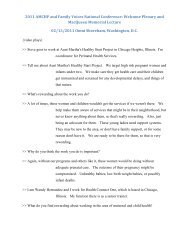Hormone Disruptors and Women's Health: Reasons for Concern [PDF]
Hormone Disruptors and Women's Health: Reasons for Concern [PDF]
Hormone Disruptors and Women's Health: Reasons for Concern [PDF]
Create successful ePaper yourself
Turn your PDF publications into a flip-book with our unique Google optimized e-Paper software.
<strong>Hormone</strong>s <strong>and</strong> <strong>Hormone</strong> <strong>Disruptors</strong><br />
<strong>Hormone</strong>s regulate a wide range of functions in our bodies. <strong>Hormone</strong> disruptors* can interfere with these functions.<br />
What<br />
they are<br />
What<br />
they do<br />
<strong>Hormone</strong>s<br />
Clear Messages<br />
Pineal<br />
Parathyroids<br />
(behind thyroid gl<strong>and</strong>)<br />
Adrenal<br />
gl<strong>and</strong><br />
Kidney<br />
Duodenum<br />
Ovary<br />
<strong>Hormone</strong>s are produced by the endocrine system,<br />
which includes the ovaries (women), testes (men),<br />
pituitary, thyroid, pancreas <strong>and</strong> other parts of the body.<br />
They are then secreted into the blood as chemical<br />
Hypothalamus<br />
Pituitary gl<strong>and</strong><br />
messengers. Examples of hormones include adrenaline,<br />
estrogen, insulin, thyroid hormones <strong>and</strong> testosterone.<br />
<strong>Hormone</strong>s direct communication <strong>and</strong> coordination<br />
among tissues throughout the body. For example,<br />
hormones work with the nervous system, reproduc<br />
tive system, kidneys, gut, liver <strong>and</strong> fat to help maintain<br />
<strong>and</strong> control body energy levels, reproduction, growth<br />
<strong>and</strong> development, internal balance of body systems<br />
(called homeostasis) <strong>and</strong> responses to surroundings,<br />
stress <strong>and</strong> injury.<br />
* <strong>Hormone</strong> disruptors are also referred to as endocrine disruptors.<br />
Thyroid<br />
Thymus<br />
Stomach<br />
Pancreas<br />
<strong>Hormone</strong> <strong>Disruptors</strong><br />
Mixed Messages<br />
<strong>Hormone</strong> disruptors are substances not naturally<br />
found in the body that interfere with the production,<br />
release, transport, metabolism, binding, action or<br />
elimination of the body’s natural hormones. Phthal<br />
ates, Bisphenol A (BPA) <strong>and</strong> DDT are some of the more<br />
commonly known hormone disruptors.<br />
<strong>Hormone</strong> disruptors can scramble messages that<br />
natural hormones transfer between cells. Usually hormones<br />
bind to hormone receptors like a lock <strong>and</strong> key.<br />
When the key fits, it unlocks the process of sending<br />
messages to regulate functions in the body. <strong>Hormone</strong><br />
disruptors can interfere with this process. For example,<br />
some can mimic natural hormones <strong>and</strong> bind to the<br />
receptors, unlocking the process but sending the<br />
wrong message.<br />
The Complexity of <strong>Health</strong><br />
No <strong>for</strong>mula currently exists that can determine the exact effects hormone disruptors will have on a woman’s health. Research indicates<br />
that the effects depend on the potency <strong>and</strong> dose of the chemical, the timing of the exposure <strong>and</strong> the individual’s overall health,<br />
which can be shaped by her genetic makeup, diet, exercise habits, racial <strong>and</strong> economic disparities, sexually transmitted diseases,<br />
access to health care <strong>and</strong> many other factors.


![Hormone Disruptors and Women's Health: Reasons for Concern [PDF]](https://img.yumpu.com/19410002/2/500x640/hormone-disruptors-and-womens-health-reasons-for-concern-pdf.jpg)













